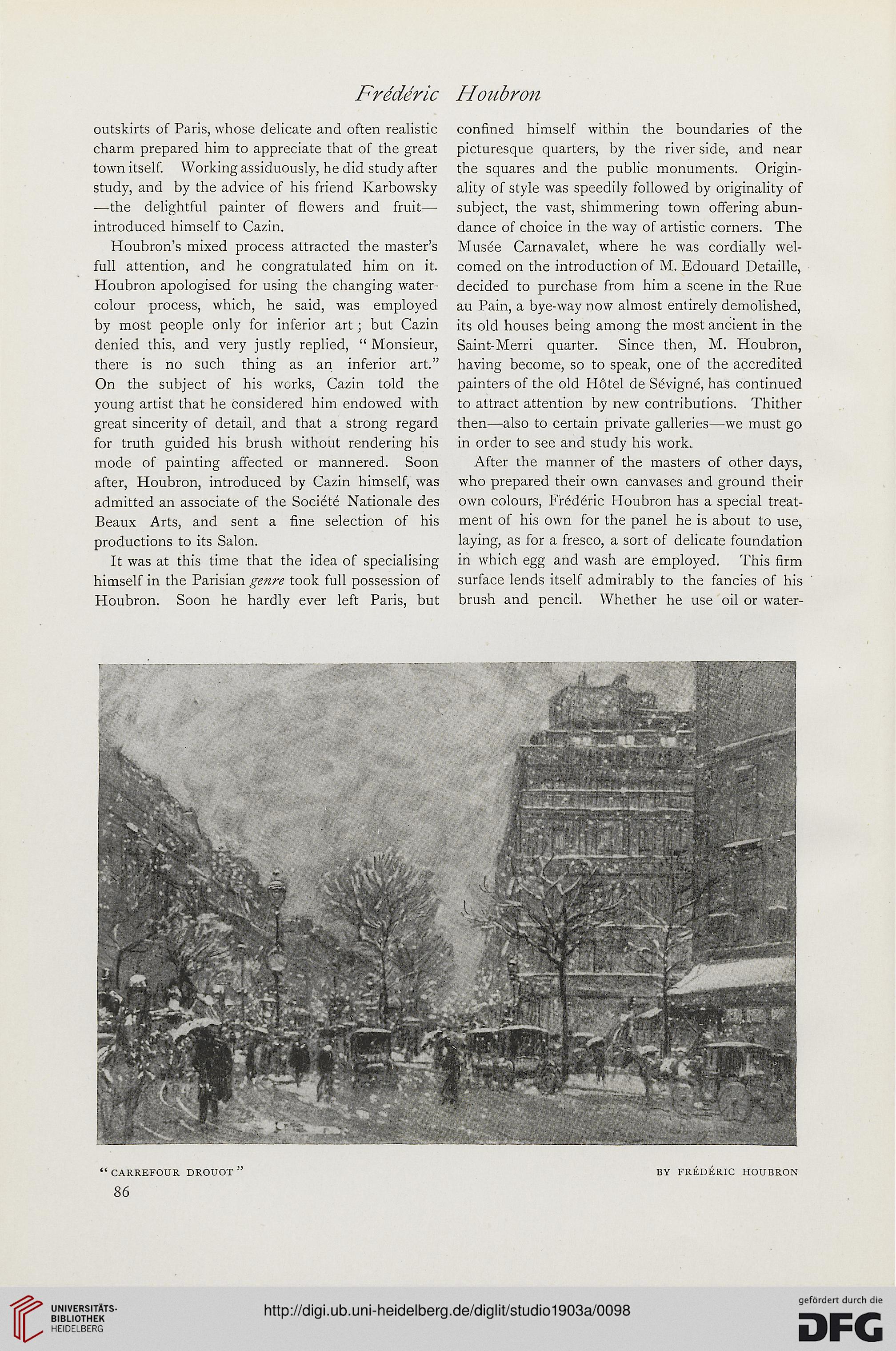Frdderic
outskirts of Paris, whose delicate and often realistic
charm prepared him to appreciate that of the great
town itself. Working assiduously, he did study after
study, and by the advice of his friend Karbowsky
—the delightful painter of flowers and fruit—
introduced himself to Cazin.
Houbron's mixed process attracted the master's
full attention, and he congratulated him on it.
Houbron apologised for using the changing water-
colour process, which, he said, was employed
by most people only for inferior art; but Cazin
denied this, and very justly replied, " Monsieur,
there is no such thing as an inferior art."
On the subject of his works, Cazin told the
young artist that he considered him endowed with
great sincerity of detail, and that a strong regard
for truth guided his brush without rendering his
mode of painting affected or mannered. Soon
after, Houbron, introduced by Cazin himself, was
admitted an associate of the Societe Nationale des
Beaux Arts, and sent a fine selection of his
productions to its Salon.
It was at this time that the idea of specialising
himself in the Parisian genre took full possession of
Houbron. Soon he hardly ever left Paris, but
Houbron
confined himself within the boundaries of the
picturesque quarters, by the river side, and near
the squares and the public monuments. Origin-
ality of style was speedily followed by originality of
subject, the vast, shimmering town offering abun-
dance of choice in the way of artistic corners. The
Musee Carnavalet, where he was cordially wel-
comed on the introduction of M. Edouard Detaille,
decided to purchase from him a scene in the Rue
au Pain, a bye-way now almost entirely demolished,
its old houses being among the most ancient in the
Saint-Merri quarter. Since then, M. Houbron,
having become, so to speak, one of the accredited
painters of the old Hotel de Sevigne, has continued
to attract attention by new contributions. Thither
then—also to certain private galleries—we must go
in order to see and study his work,.
After the manner of the masters of other days,
who prepared their own canvases and ground their
own colours, Frederic Houbron has a special treat-
ment of his own for the panel he is about to use,
laying, as for a fresco, a sort of delicate foundation
in which egg and wash are employed. This firm
surface lends itself admirably to the fancies of his
brush and pencil. Whether he use oil or water-
; CARREFOUR DROUOT BY FREDERIC HOUBRON
86
outskirts of Paris, whose delicate and often realistic
charm prepared him to appreciate that of the great
town itself. Working assiduously, he did study after
study, and by the advice of his friend Karbowsky
—the delightful painter of flowers and fruit—
introduced himself to Cazin.
Houbron's mixed process attracted the master's
full attention, and he congratulated him on it.
Houbron apologised for using the changing water-
colour process, which, he said, was employed
by most people only for inferior art; but Cazin
denied this, and very justly replied, " Monsieur,
there is no such thing as an inferior art."
On the subject of his works, Cazin told the
young artist that he considered him endowed with
great sincerity of detail, and that a strong regard
for truth guided his brush without rendering his
mode of painting affected or mannered. Soon
after, Houbron, introduced by Cazin himself, was
admitted an associate of the Societe Nationale des
Beaux Arts, and sent a fine selection of his
productions to its Salon.
It was at this time that the idea of specialising
himself in the Parisian genre took full possession of
Houbron. Soon he hardly ever left Paris, but
Houbron
confined himself within the boundaries of the
picturesque quarters, by the river side, and near
the squares and the public monuments. Origin-
ality of style was speedily followed by originality of
subject, the vast, shimmering town offering abun-
dance of choice in the way of artistic corners. The
Musee Carnavalet, where he was cordially wel-
comed on the introduction of M. Edouard Detaille,
decided to purchase from him a scene in the Rue
au Pain, a bye-way now almost entirely demolished,
its old houses being among the most ancient in the
Saint-Merri quarter. Since then, M. Houbron,
having become, so to speak, one of the accredited
painters of the old Hotel de Sevigne, has continued
to attract attention by new contributions. Thither
then—also to certain private galleries—we must go
in order to see and study his work,.
After the manner of the masters of other days,
who prepared their own canvases and ground their
own colours, Frederic Houbron has a special treat-
ment of his own for the panel he is about to use,
laying, as for a fresco, a sort of delicate foundation
in which egg and wash are employed. This firm
surface lends itself admirably to the fancies of his
brush and pencil. Whether he use oil or water-
; CARREFOUR DROUOT BY FREDERIC HOUBRON
86




